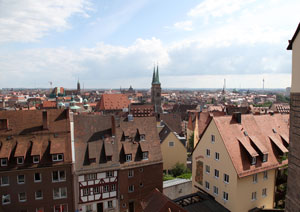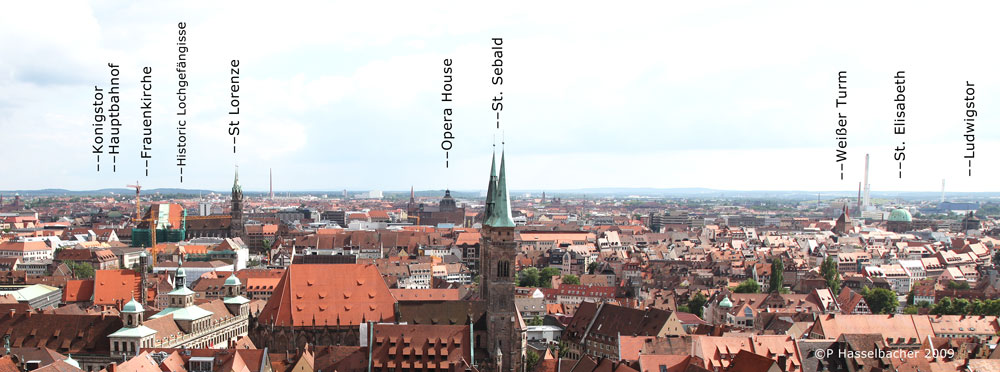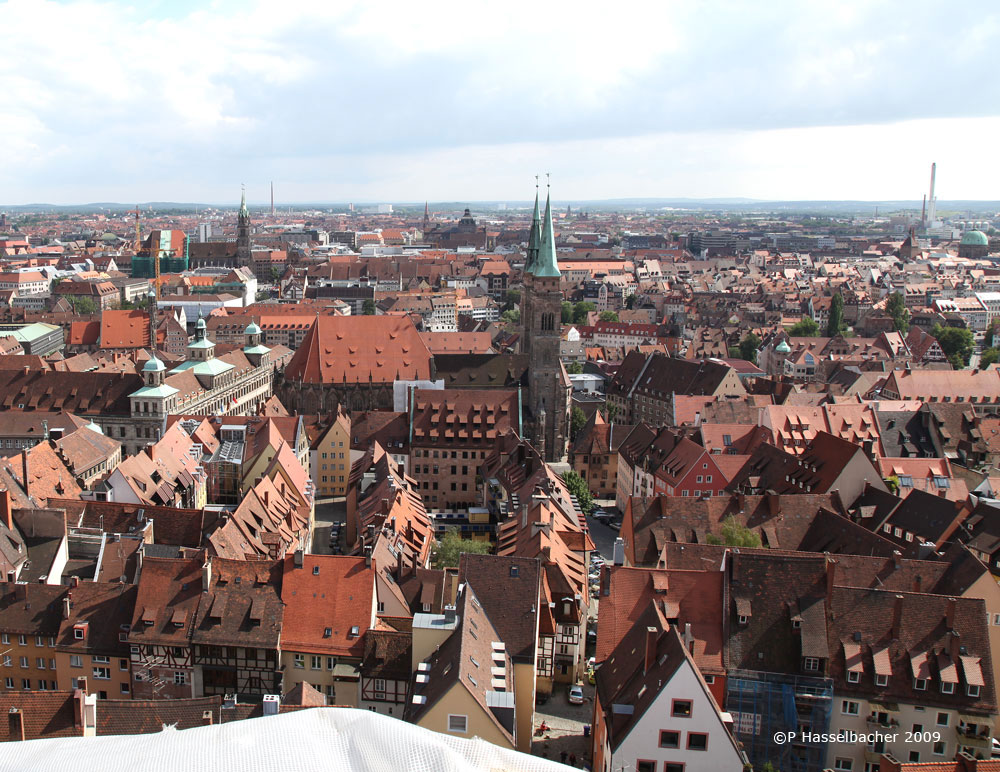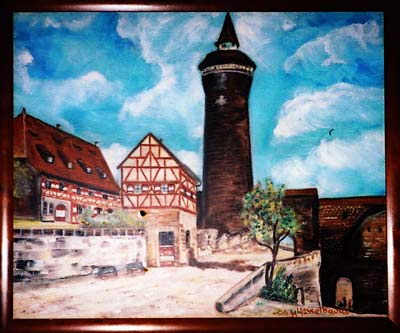In earlier pages, I introduced an old painting of the City of Nürnberg. When I visited the city in June of 2009, I was able to clarify at least two of the mysteries surrounding this 1939 family painting of Nürnberg that has been in our American family since the early 1950's. I have a pretty good idea of the exact vantage point used by the artist, and I was able to learn a little more about the artist himself.
It was already clear that the artist painted his landscape from some vantage point near the Kaiserburg, or Imperial Castle. A number of potential vantage points were possible. The highest point within the Castle complex is the Sinwell or Round Tower. To the west of it and attached to the chapel complex is is a somewhat lower square tower called the Heathen's Tower. Somewhat below the base of the round Tower, and to the east (left if you are facing the city) is a stone plaza overlook accessible to the public. (I believe this is called the Burgfreiung, referring to a place of protection or sanctuary.) Additionally, below the Sinwell Tower, and between it and the city is a complex of old buildings that were once part of the castle wall defenses or stables, but now are private buildings inaccessible to me. These features of the castle can be seen in accompanying labeled images. See also a photogallery of images of the castle and landmarks in the city featured in the painting.
Complicating my adventure was the fact that the round tower was undergoing extensive restoration and was surrounded by scaffolding with a broad awning below the observation windows at the top. As it happened, the scaffolding turned out to be as much a feature as a problem.
It was a nicer day than my previous visits but still not perfect for photos. I returned to the observation balcony below the castle and nearly reproduced my photograph of two years before. [Click on the small images to see a larger one.]

This time I had a copy of the painting with me. It was again clear that I needed to be further to my right and higher to reproduce the painter's perspective. A number of features allow a viewer to judge their position with respect to the painting and the city. These include the orientation of the small cupola or lantern on the Frauenkirch with respect to the three cupola on the historic Town Hall, and with the bell towers of St. Lorenze Church. Additionally, the position of the dome of the Opera House with respect to St. Sebald in the middle of the picture is useful. Finally, the positions of the various domes and steeples with respect to the horizon line are helpful to estimate height above ground of the vantage point. As will be apparent, it was not possible to line everything up exactly as it is in the painting. I learned however, that such inaccuracy is to be expected. Nonetheless, I believe it was possible to identify the vantage point with an accuracy within 10 to 20 feet in any direction. Here is an image of the modern skyline with the most prominent landmarks identified.

- Konigstor is one of the large round towers at a gate emblematic of the city.
- Hauptbahnof with its green dome is the railroad station just outside the old walls.
- Frauenkirche with its animated clock sits in the middle of the old market square.
- Historic Lochgefängisse with its three copper cupola is the old city hall.
- St. Lorenze is one of the two big cathedrals.
- The Opera House with its dome sits just outside the walls.
- St. Sebald is on the near-side of the Pegnitz river and is in the center of the photo.
- Weißer Turm or white Tower is square and is a subway exit today.
- St. Elisabeth is a Catholic Church with a round dome.
- Ludwigstor is a city gate with a round tower. (I need to confirm the name of the tower)
Photos of the individual landmarks are presented in this photogallery.
Climbing the Tower
My next task was to climb the tower. The climb and the view were exhilarating, but a little disappointing for the purposes of this project. The observation windows were small and had heavy close-set bars that made it difficult to photograph in between them. Additionally, a broad construction awning projected into the field of view and prohibited any downwards look. The best picture (just below) was taken from a window that was not the most central one None-the less, it was obvious that in terms of the left to right orientation, we were pretty much in the right place. In fact, I wondered however if we were not too high! In the painting (keep this window open for comparison) the steeples of St. Sebald project well above the horizon, but from the top of the Sinwell Tower they barely protrude above it. At this point, the bottom of the tower was too low, but the top seemed too high. In the belief that I was close to my goal, I descended to reevaluate my strategies.

The Tower was covered in scaffolding, but there was an external construction elevator going up the side. On the theory that I have come to expect kindness from strangers, and using my broken German, I showed the painting and explained my predicament to the workmen restoring the round tower. They became interested, and to my delight, they were willing to take me up in the construction elevator. With a picture in one hand while we were ascending, we stopped the elevator when things more or less generally lined up. (The photo of the labeled skyline above was taken from this position of the elevator.) Of note, we were only halfway up the tower! This was puzzling to me because there are not now, nor is there any evidence that there ever were windows halfway up. Eventually another hero came to my assistance and corrected my logic!
In the meantime, I snooped around the Castle looking for potential alternative sites. The private buildings in the wall below the tower that might line up correctly left-to-right were not open to me (I knocked!). These windows seemed too low in any event. Look here for images of the layout of the Castle.
The only remotely feasible alternative was the square tower. I then went into the Museum of the Castle and displayed my goods and my interest to the castle staff, one of whom was an artist. To my delight, I was able to take photographs from the main rooms of the castle where it was obvious we were too low and much too far to the right. In the interest of history and science I was escorted to the top of the square tower which is usually off-limits to casual tourists. The height was not too bad (St. Sebald was still too low) but it was clear that we were much too far to the right.
Mystery Explained
When people saw what I was doing, they became interested in my project and were extremely helpful to me. One of the staff of the castle was himself a painter and pointed out what should have been more obvious to me. I was working with my scientific and photographic mind and not the left side of my brain. I should not have been expecting a photographic reproduction! An artist will always select certain features to emphasize and present in greater detail and will feel free to manipulate perspective and color to achieve the desired effect.
For example, even allowing for the substantial reconstruction that must have occurred following the war, it is probably physically impossible to include in the perspective the closest rank of houses together with the remainder of the city. (More than a single vantage point may have been used.) An observer will also notice that there is some horizontal distortion as well. In the painting the dome of the opera house lies to the right of the center of the frame. In the modern photographs, the dome lies to the left of center. That is to say, the right side of the painting is more compressed than the left. Artistically this makes sense because there are more architectural details of interest in the left side of the painting.
If the artist painted his landscape from the top of the Tower, as I now believe he did, the steeples of St Lorenz would hardly protrude above the horizon. If nothing intruded into the sky above the horizon at all, the painting would be unbalanced and less interesting. Artistic license was used to add the front rank of houses, to look into the street below, to compress the right side of the frame, to elevate some steeples, and to select specific landmarks for special detail. I applaud the effort!
I am not familial enough with Nürnberg to identify other structures with authority. I understand that during the war, the city was reduced largely to rubble and the castles and cathedrals were heavily damaged as well. Although not every major structure may have been built to the same height, for the most part, the landmarks I discuss here were built in the same places. I also acknowledge that the artist may have been working from photographs (black and white?) entirely or in part. To capture the color and the haze of smoke, and the mood, I have little doubt that A. Wild visited the tower him- or herself.
Following my adventure, I found some images of Nürnberg taken from the tower before and after WWII. View them here.
Who was A. Wild?
Having identified the vantage point of the painting to my working satisfaction, how about its maker -- A. Wild? Before my trip, I could find nothing on the Internet about this artist. The area of the city below the castle has many antique and art stores. I went into a few of these and asked if anyone was familiar with the painter's name. No one was. In one store, a staff member took the trouble to access their professional database of artists without result. It was suggested that the artist may have been an "hobby" painter.
On the last day of my trip, I visited one of my two living cousins in Nürnberg. He remembered that the painter had been a friend of the family and indeed, my cousin owned another painting by him. (I use the masculine gender but I failed to ask or remember what the "A" stands for!)
Moral of the Story
The results of this inquiry were hardly earth-shattering. There are many other family history puzzles that I would rather solve. So why did I feel so self-satisfied then and now? This mundane challenge provided me a wonderful afternoon, opened (literally) new doors, allowed me to meet some very nice people (one of whom told me where the locals eat dinner), allowed me to play with my camera, and helped me fill in the provenance of a precious family heirloom. This and similar adventures large and small provide me what may be an unnecessary excuse to travel, and yield experiences that I would not have otherwise have nor would have wanted to miss. I recommend the process to you heartily.
Just For Fun
 Here is a painting of the Kaiserberg by a contemporary German Hasselbacher who lived in Nürenberg. I know this viewpoint!
Here is a painting of the Kaiserberg by a contemporary German Hasselbacher who lived in Nürenberg. I know this viewpoint!